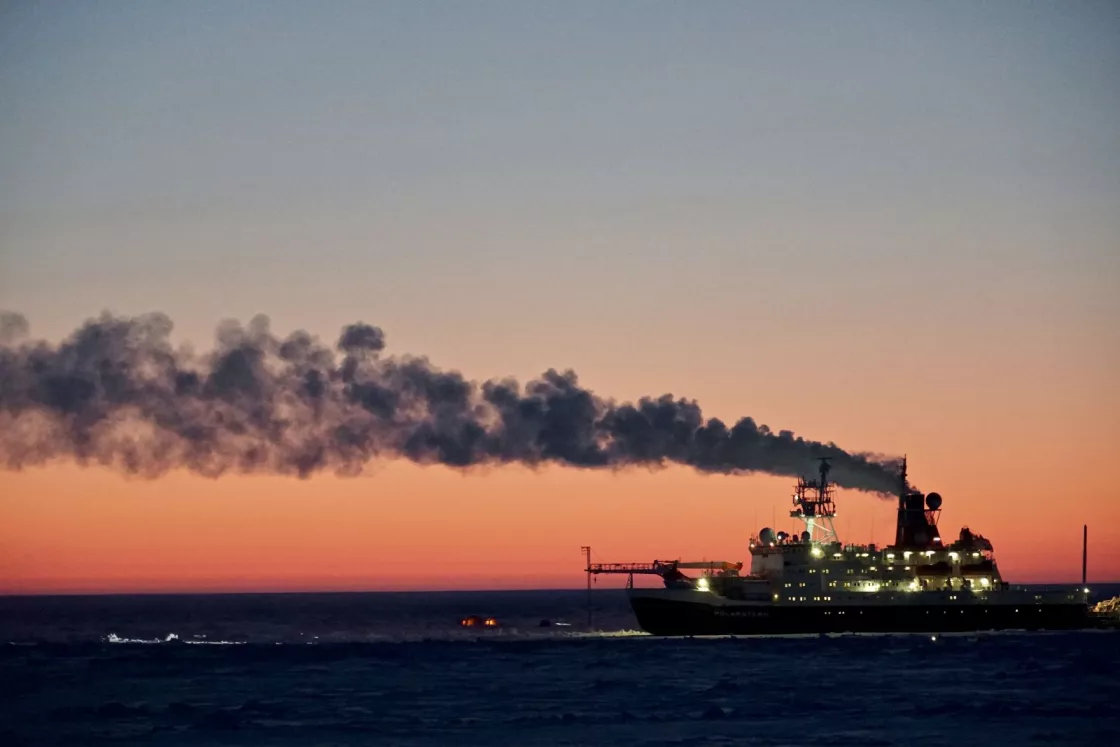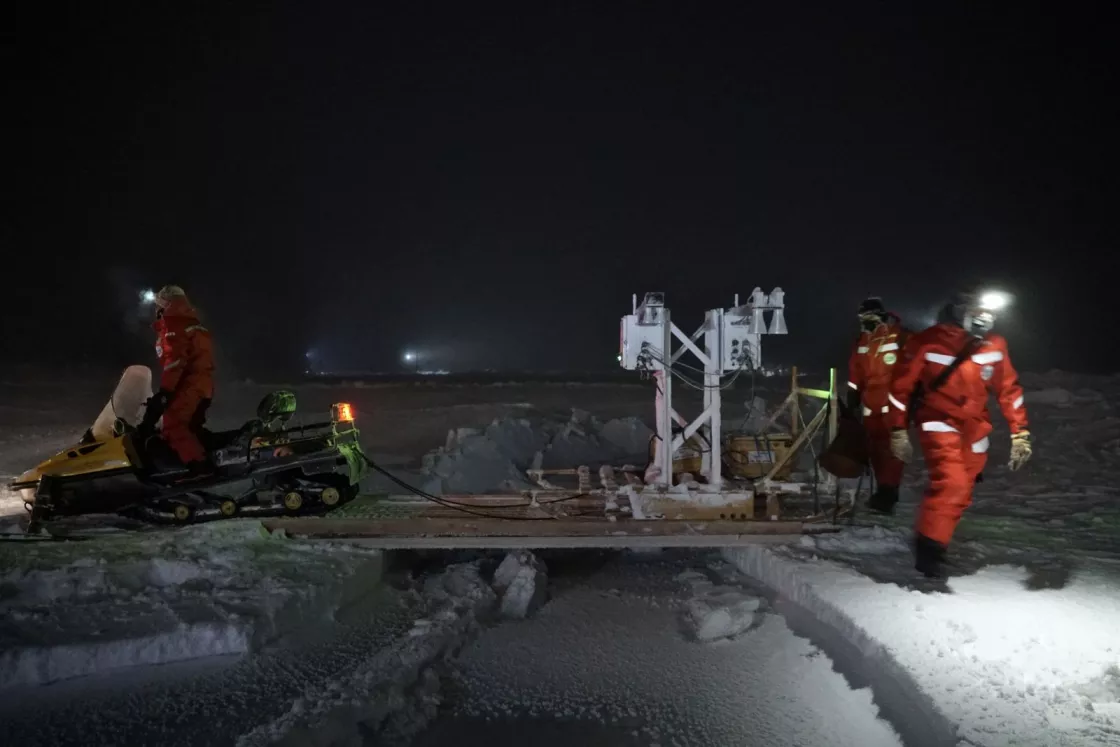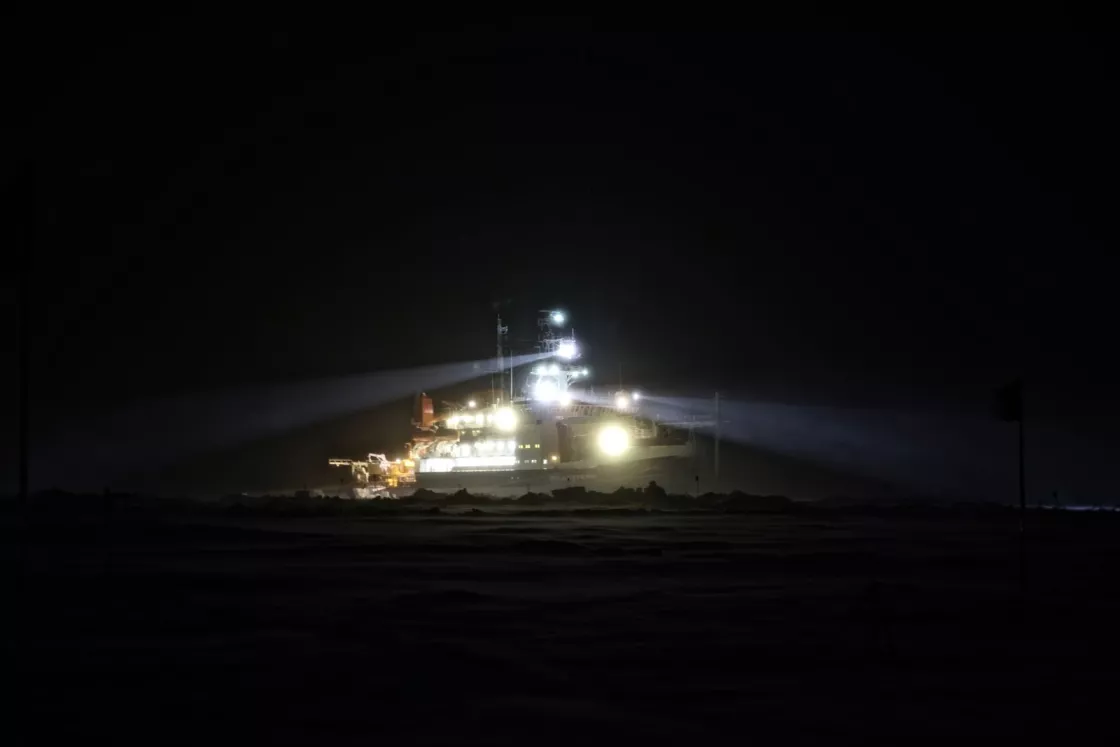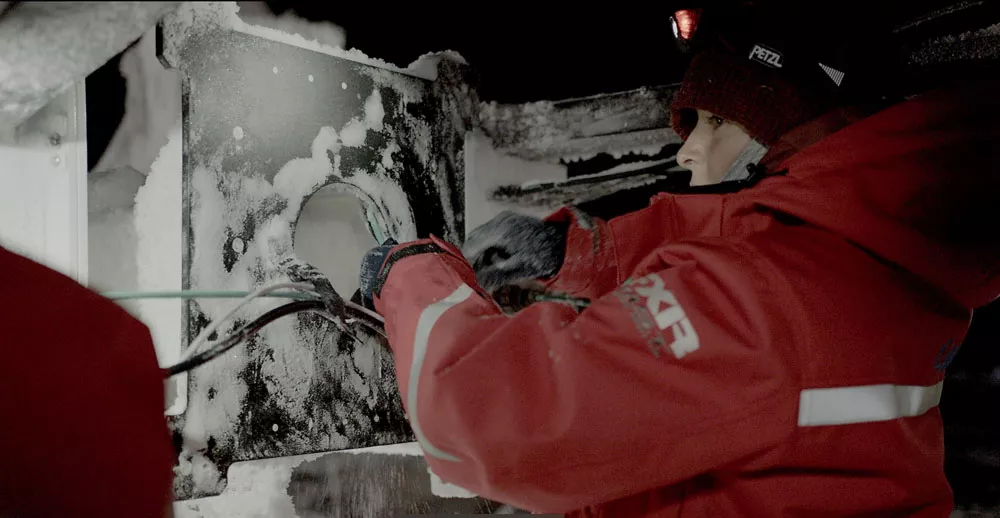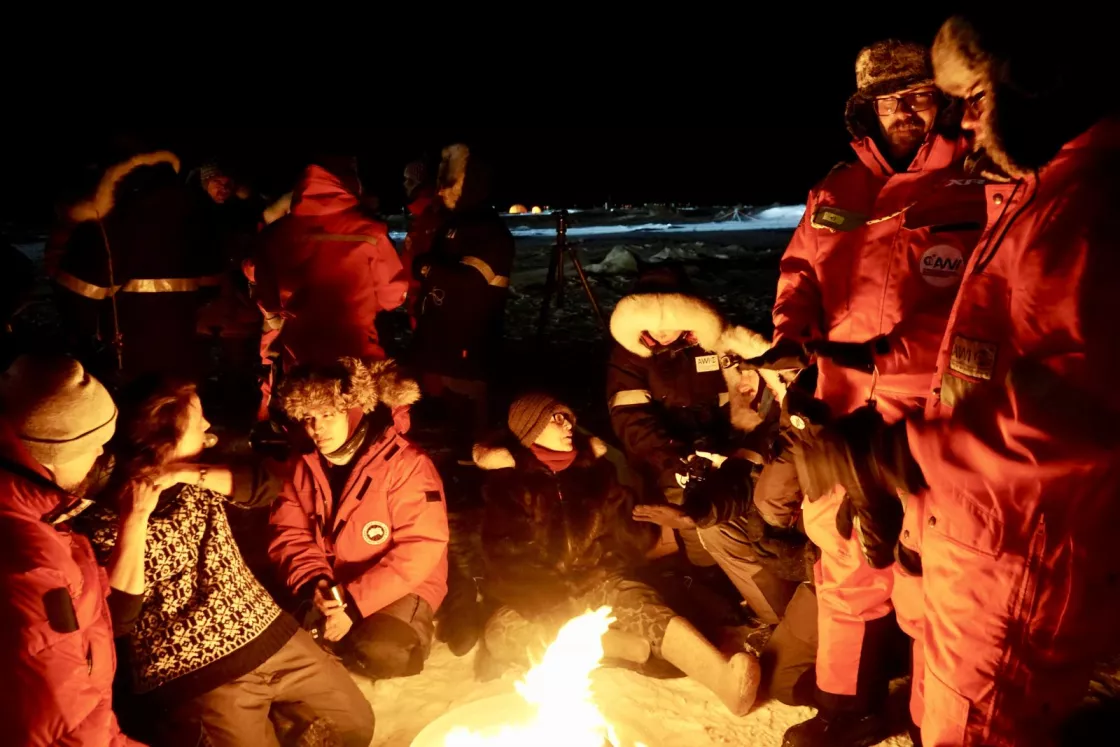By Agnieszka Gautier
Under the extreme conditions of an Arctic expedition, one with sweeping and ambitious plans, the unexpected is to be expected. In September 2019, the German research icebreaker Polarstern locked into Arctic sea ice for what was to be a yearlong expedition, called the Multidisciplinary drifting Observatory for the Study of Arctic Climate (MOSAiC). However, in May 2020, months ahead of schedule, it left a fractured ice floe to resupply and exchange researchers in Norway’s Svalbard. Before leaving, scientists had to remove certain instruments or risk them falling into the Arctic Ocean.
On June 17, 2020, after a month away, the R/V Polarstern returned to collect data from the remaining instruments, which garnered energy exchange measurements between the ocean, ice, and atmosphere. With the peak melting season, a time when sea ice is most vulnerable to cracking and disappearing, the ship may not be able to stay long and may have to search out a more stable floe. Therefore, the equipment and stations surrounding the ship will need to be highly mobile to adapt to rapid changes.
NSIDC researcher Julienne Stroeve returned to land from the expedition at the beginning of April. Upon her return, we sat down to discuss her trip, research, and how her expectations turned out. This is the second part of her MOSAiC story. Read part I here.
A radar and its data
At the center of Stroeve’s journey is a $600,000 radar that will characterize radar penetration through the snow on sea ice to refine measurements of sea ice thickness and snow depth from satellite data. The instrument tests how two different radar frequencies, Ku and Ka, interact with the snow and ice. Radar is meant to penetrate through to the snow-ice interface at Ku-bands but depending on different snow properties—compact or fluffy, soggy or dry, new or old—the bounce back could come sooner. “If it’s not coming from the snow-ice interface, you would assume the ice is thicker than it really is using Ku-band radar altimeters on satellites like CyroSat-2,” Stroeve said. This may be one reason why the differences between the two satellites that estimate sea ice thickness—the NASA Ice, Cloud, and land Elevation Satellite-2 (ICESat-2) and the European Space Agency (ESA) CyroSat-2—can be as large as one meter.
CryoSat-2 uses radar to penetrate through the snow to the ice surface, while ICESat-2 reflects a laser off the top of the snow surface. With some additional data, such as knowledge of how much snow is on the ice and its density, scientists are able to use the reflections from ICESat-2 to calculate sea ice thickness. ICESat-2 data is currently available at the NASA NSIDC Distributed Active Archive Center.
Stroeve’s radar started collecting data in mid-October, when the R/V Polarstern first locked into the ice floe and set up the various stations around the ship. The expedition was originally split into six legs and divided between 600 experts from 20 countries. Storms, ship delays, and COVID-19 interruptions meant the timelines got scrambled leading to an extra-long second leg for Stroeve. After four and a half months drifting in sea ice, Stroeve reflected on her time.
Arriving on the ice floe
When Stroeve arrived in late November, it was already dark. “I had a sun lamp and grew sprouts with it,” Stroeve said. “I actually didn’t use it as much as I thought I would. I guess you get used the darkness.” In complete darkness, time lost meaning. “I started going to bed at three or four in the morning and I’d sleep until 11:00am. It was so dark it really didn’t matter.”
Just before Stroeve’s arrival, the first tempestuous storm blew in, breaking up sea ice and compressing the pieces into stacked contortions. Scientists had to quickly move equipment off the ice. “We expected our instruments to be set up when we arrived,” Stroeve said, “but they weren’t. Nothing was working when we arrived.”
To make matters worse, the dozens of cables coming out of the small power shack were tangled and unlabeled. Stroeve and her team worked in -30 to -40 degrees Celsius (-22 to -40 degrees Fahrenheit) trying to unravel the mess. “The cables did not want to bend or move easily,” she said. “It was a lot of work just to rebuild the site. Things kept breaking on us all the time.” They worked two hours in the mornings and then four in the afternoon. Anytime the scientists took their gloves off to work on the equipment, their fingers froze immediately. Thankfully, there was a warming hut. “If we didn’t have that hut, we wouldn’t have survived out there.”
Even in winter, sea ice is dynamic. During Stroeve’s time, in the coldest, darkest portion of the year, leads kept opening in the sea ice. Wooden planks served as bridges to cross open water. Eventually, they moved the shack of cables closer to their instruments for fear of severing the power source. Unfortunately, one of Stroeve’s biggest apprehensions came true.
A bad break
“My radar broke at the end of January,” Stroeve said, slouching into disappointment. She had spare parts in Svalbard ready to go on an aircraft campaign that would have fixed her radar in mid-March, but the campaign was canceled because of COVID. When the R/V Polarstern returned in mid-June, it brought the parts and the radar started collecting data again at the end of the month. “Quite a gap,” Stroeve said. Still she thinks the data it collected prior to its break was highly insightful. “When it worked, it worked really well,” she added. But why did it break?
“It was a prototype,” she said. On the ice floe, it scanned every hour and made observations from a range of angles. Once a week, the scientists strapped it to a skidoo to get transect readings. Besides a polar bear being caught red handed on camera messing with the wires, this towing most likely loosened its wires. “We started noticing failures where the instrument would just shut down,” Stroeve said. After ten days of doing this, the team brought it inside and opened it up to find loose wires and bolts, and then the entire circuitry got fried. “We may have turned it on too soon after bringing it in,” she added.
Temperatures in snow matter
Back behind a computer, Stroeve is already working on analyzing the data from mid-October through the end of January. The initial data show that the reflections from the Ka- and Ku-band frequencies vary depending on snowpack and atmospheric conditions. Since ESA is considering a dual satellite mission with Ka/Ku bands, Stroeve’s research suggests it is possible to get snow depth and ice thickness at the same time. “That’s going to take some more research to see how well it does getting both, but the potential is definitely there,” Stroeve said.
With continued readings through the melt season, Stroeve’s radar will also give insight into how the frequencies interact with moisture and increased temperatures. A more detailed analysis will follow that shows how temperatures, salinity, and grain size influence the radar reflections. “It’s interesting because we can already see how snowpack temperatures influence the results,” Stroeve said. For instance, when the snowpack warmed by 20 degrees Celsius (36 degrees Fahrenheit), the backscatter at both bands increased, meaning the reflection signal changed where in the snow it was coming from and so snow temperature can influence sea ice thickness estimates.
In addition, the data show that salt or ice in the snow disrupts the radar signal, blocking its way through to the snow-ice interface and reflecting signals prematurely. Saline snow, which tends to fall on first-year ice, inflates sea ice thickness measurements. “As we transition to more first-year ice cover, which we’ve been doing, we may be completely overestimating how thick the ice is.” Now Stroeve’s data can help rectify these measurements.
A collaboration of information
From birthday cakes, sauna nights, and Saturday bar nights run by the scientists to Christmas parties and outdoor bonfires, the scientists got to know each other really well. “I was really happy on the boat and enjoying what I was doing,” Stroeve said. “We really bonded and were sad to leave each other.” With no internet, people resorted to the old face to face contact. They played games, talked, and filmed documentary movies together. “I played charades for the first time and it turns out I’m actually pretty good,” she said.
This bonding is vital for the ice team on MOSAiC. Stroeve’s radar is absolutely useless without snowpit and snow depth data. “Some people may have measurements that were self-contained, but for us, our measurements depend on what everyone else is collecting. It’s a huge group effort,” Stroeve said. “We need the other data to interpret our measurements.”
With MOSAiC having an open sharing data policy, and the close relationships formed, the hope is that these types of expeditions lead to stronger collaborations and a better understanding of our planet under global warming. As the Arctic warms at double the rate of the rest of the globe, the scope of this expedition is key to unlocking how the Arctic climate system functions and what potential impacts may ripple to the rest of the planet.
Access data through the NSIDC DAAC
NASA's NSIDC DAAC manages, distributes, and supports a variety of cryospheric and climate-related datasets as one of the discipline-specific Earth Science Data and Information System (ESDIS) data centers within NASA's Earth Science Data Systems (ESDS) Program. User Resources include data documentation, help articles, data tools, training, and on-demand user support. Learn more about NSIDC DAAC services.
